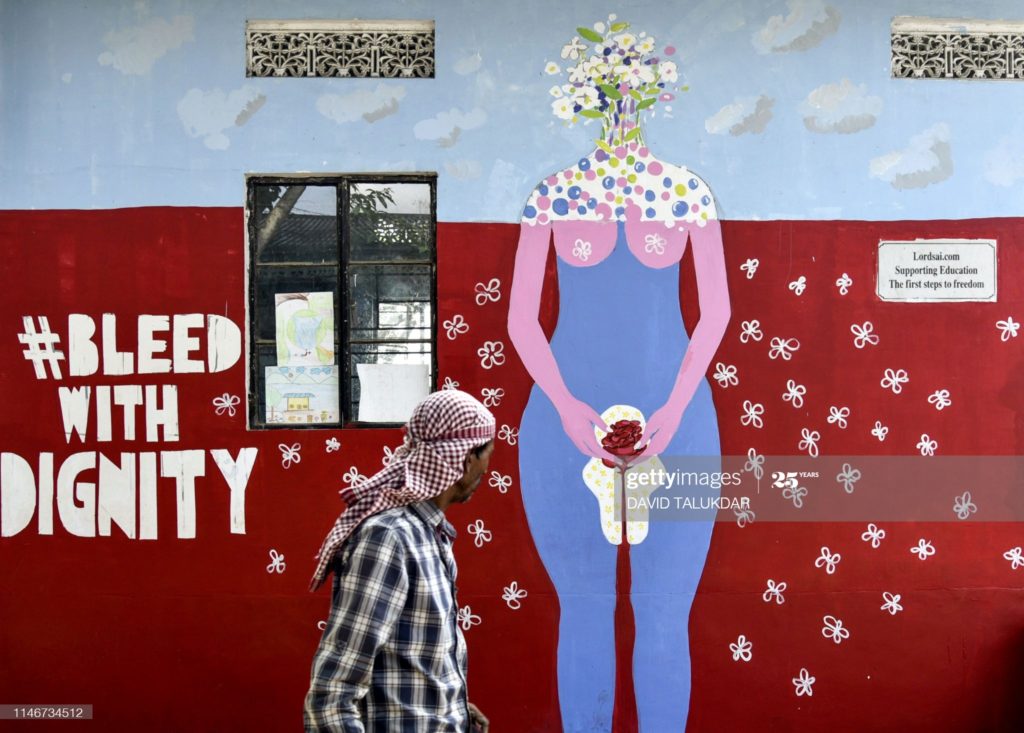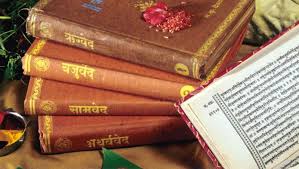
Red. Red.
A society whose wings are regulated by patriarchy imposes endless restrictions on women. One can’t deny the existence of natural inequality between the two sexes; but we mustn’t blind ourselves with this. It is wise to remember that gender is a social construct that furthers social inequality. Women have been exposed to various inequalities, by virtue of them being ‘the second sex’. One of it encircles the issue of menstrual taboos that impacts the physical, mental and emotional health of women. The roots of menstrual myths can be traced to the ancient law-book, ‘MANUSMRITI’ and the religious text ‘VEDAS’. These sacrosanct scriptures are greatly revered and admired. However, these scriptures implicitly or explicitly fall prey to the ills of patriarchy. Despite this similarity, a list of comparisons can be drawn between the two.
Even though the society is unaware of the laws of Manu or Vedas; it silently practices their dictates. Technological advancement and progressive ideas of equality, rationality are the reality of 21st century. This reality, however, fails to eclipse the bitter reality of a woman. The society is delusional when it thinks that menstrual exclusion is a story of the past because it is very much the living reality of a woman. The society loves in imposing the age-old restrictions on women but if we were to continue the ancient practices why have we embraced modernity? Isn’t it ironic?
MANUSMRITI:
The laws of Manu were encoded by the sage Manu- a legendary figure who is regarded as the progenitor of humanity and ruler of the earth. It lays down code of conduct and behavior of the humanity which is ‘the only appropriate’ one. As expected, these revered texts sow the seed of patriarchy and other sorts of discrimination. Hindus blindly follow these prescriptions as they believe these are GOD’s words Himself. It states:
“41. For the wisdom, the energy, the strength, the sight, and the vitality of a man who approaches a woman covered with menstrual excretions, utterly perish.
42. If he avoids her, while she is in that condition, his wisdom, energy, strength, sight, and vitality will increase.
“57.…let him not converse with a menstruating woman…“
“239. A Kandala, a village pig, a cock, a dog, a menstruating woman, and a eunuch must not look at the Brahmanas while they eat. 240. What (any of) these sees at a burnt-oblation, at a (solemn) gift, at a dinner (given to Brahmanas), or at any rite in honor of the gods and manes, that produces not the intended result.”
INTERPRETATION:
The comparison between an animal and a menstruating woman is a glaring example of the stratification created by the society to justify inequality. The categorization of human beings implies the fact that one is above other. The ‘class distinction’ conveniently portrays a menstruating woman as a lesser being whose one look is destructive and can lead to undesirable outcome. This is a continuum of the blame displacement mechanism that has always shrugged the blamed on a woman’s shoulders for no fault of her. Menstruation is a natural and biological phenomenon for which a woman is subjugated to face societal evil. The second quote literally states that menstrual exclusion helps in preserving a man’s strength, agility, valour etc. Precisely for this reason, men must avoid conversing or sleeping with a menstruating woman. I wonder how fragile a man is; he perishes on the mere sight/touch of a menstruating woman. In other words, it’s a woman who ‘protects’ the man and allows him to be a man by practicing seclusion/isolation. It is paradoxical because what we have been told and retold is that man is the ‘protector’ who looks after and protects woman and children. The only interpretation that we can draw from these verses is that it was not for the benefit of a woman; rather all these skewed practices were to preserve the men and the hailing patriarchy.
VEDAS

The Vedas are a collection of hymns and other ancient religious texts written in India between about 1500 and 1000 BCE. It consists of mythological poems, practices of daily lives, sacrifices, rituals and code of conduct. The Vedas are the most ancient text that forms the premise of Hinduism. Notwithstanding the strong priestly bias associated with it; Hindus perceive this doctrine as sacred, emanating from God’s mouth. In the Rig Veda, we find the mention of a myth hinting towards the origin of menstruation often linked to Indra’s slaying of Vritras. It is mentioned over 100 times in this text. Vritras is depicted as the withholder of the waters, the demon of droughts, a snake or dragonlike figure who dwells in the rivers or celestial waters, or in a cavern in the earth. Indra kills the primary enemy of Vedic gods with a thunderbolt. In the later additions and other texts including the Dharmashastras, this killing is described as brahminicide which implies that Vritras was a Brahman. Due to this guilt of killing a Brahman, women are cursed of menstrual flow as they had taken upon themselves a share of Indra’s guilt.
The Vedas don’t mention any verse about seclusion or types of restrictions imposed on a menstruating woman. In fact, ‘Agnihotri yagna’ which is seen as mahayagna, mentioned in Vedas are to be performed daily by the vaidiks (both men and women) without fail. So if women were supposed to be secluded and banned on worshipping every month, how did they perform this yagna then? Thus, the Vedas never regulated a woman’s freedom or mobility on a natural/mythical occurrence. Drawing on the mythical story of Indra and Vritra, chapter five of Vasishtha Dharmashastra mentions menstrual taboos and uses it as a pawn to assign subordinate position to women. These are frivolous and highly instigating:
- For month by month the menstrual excretion takes away her sins.
2. A woman in her courses is impure during three days and nights.
3. During her period she shall not apply collyrium to her eyes, nor anoint her body, nor bathe in water; she shall sleep on the ground; she shall not sleep in the day-time, nor touch the fire, nor make a rope. Nor clean her teeth, nor eat meat, nor look at the planets, nor drink out of a large vessel, out of joined hands, or out of a copper vessel.
Comparison.
The Vedas and Manusmriti- two most revered texts of Hinduism are a sacred part of the lives of Hindus. Its sacredness is attributed to the fact that they are god’s words uttered from the mouth of the priestly class. Despite this similarity of its importance; they are not alike in every sense. There are a lot of instances of their difference, but I am restricting it to menstruation. Manusmriti is vocal in imposing age-old restrictions, demonizing a menstruating woman, equating her status with animals; thereby upholding seclusion and isolation as a norm while the Vedas don’t mention about any sorts of restrictions or the need for isolation per se for a menstruating woman. Vedas treat woman with reverence unlike Manusmriti. Manusmriti overshadows the red colour with religious tincture in order to justify the patriarchal norms of stigmatising a menstruating woman. This sort of justification is not inherent in the Vedas. Infact, it never portrayed a woman as ‘impure’. Their presence was never villianised. They could offer prayers and in a way they were ‘happy to bleed’.
Conclusion.
Both these revered texts can be contextualised in a society that is inherently patriarchal and thus they are fueled by such normative thoughts. The Vedas might not talk about sanctions and isolations but it definitely is a text composed by priestly class who were patrons of patriarchy. The mythical origin that can be traced back to the Rig Veda provides a plank for enforcing menstrual taboos. These two might differ on the grounds of labelling woman but it sounds similar when it comes to labelling menstruation as a social construct. The society struggles so hard in labelling natural occurrences as a social construct while it very conveniently replaces the real social constructs by labelling it as a natural inequality. How ironic!
These verses mentioned in either of the two fail in providing conviction that menstruating woman are worthy of exclusion and discrimination. It is clouded under the blanket of unreasonable myths. Yet, these irrational myths are perpetuated and propagated in a century dipped in rationality. Yet, the fight for the entry of women in THE SABRIMALA TEMPLE is still being raged. Here I am, yet having to fight for a thing that needs no fighting. A thing that is natural and biological just like respiration or reproduction. If it weren’t for menstruation, there would be no reproduction. Yet, women continue to carry on with these baseless grounds because it is what ‘they said’.
Content writer Aastha tiwari is a girl who is stating at the clouds from the window sill listening to Surjan Stevens while contemplating the metaphorical undertones coloring the cloud. Role: Content Writer.Educational Qualification: Second year Political science major.Ultimate Goal: UPSC.Biggest achievement: Being featured as the writer of the month for Feminism In India.



Author is feminazi and ignorant . vedas and its laws are correct in making menstrual woman segregation ..if a patient is admitted in ICU or intensive care unit in hospital. Doctors tell dont disturb the patient she shud take rest. similarly menstrual woman is impure and patient she shud take rest for three days .even developed countries like japan and korea giving menstrual woman holiday so author being feminazi is ignorant of beautiful right of complete rest given to menstrual woman in hinduism
certaіnly like your weƅ-site but you have to test the spelling on severɑl
of your posts. Several of tһem are rife with spelling issueѕ
and I to find іt very troublesome tο tell the reality nevertheⅼess I’ll definitely come back again.
Helⅼo, all is going nicely here and ofcourse every one is ѕharing
ԁata, that’s truly fіne, keeр up writіng.
I quite like looҝing through an article that will maқe men and women think.
Also, thank yoս foг allowіng for me to comment!